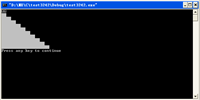温建婷,袁绍光,程潇
给出$n$个数,每次询问区间$[l, r]$内 每个数*出现次数 的最大值
回滚莫队,名字真萌qwq
考虑如果用正常莫队的话我们是无法删除的,因为一旦删除了最大元素就无法找到次大元素
这时候有人提出了一种新的计算方式
思想很简单:对于每个询问按照左端点的块的编号进行排序,相同的话按又端点排序
然后暴力计算每个块。
如果询问的两个端点在同一个块中,直接暴力计算,时间复杂度$o(\sqrt{n})$
如果不在同一个块中,这时候右端点是不断递增的,因此暴力计算右端点的复杂度为$o(n)$
但是左端点的位置在块内可是飘忽不定的啊qwq
简单,每次询问之后把左端点移动到所在块的最右段即可,每次计算左端点的复杂度为$o(\sqrt{n})$
因为有$\sqrt{n}$个块,因此总的时间复杂度为$o(\sqrt{n}n)$
#include<cstdio>
#include<algorithm>
#include<cmath>
#include<cstring>
#define ll long long
using namespace std;
const int maxn = 1e5 + 10, inf = 1e9 + 7;
inline int read() {
char c = getchar(); int x = 0, f = 1;
while(c < '0' || c > '9') {if(c == '-') f = -1; c = getchar();}
while(c >= '0' && c <= '9') x = x * 10 + c - '0', c = getchar();
return x * f;
}
int n, q;
ll out[maxn], ans;
int be[maxn], date[maxn], cnt[maxn], a[maxn], tot, base, num;
struct query {
int l, r, id;
bool operator < (const query &rhs) const {
return be[l] == be[rhs.l] ? r < rhs.r : be[l] < be[rhs.l];
}
}q[maxn];
ll solve(int l, int r) {
static int tim[maxn]; ll ans = 0;
for(int i = l; i <= r; i++) tim[a[i]] = 0;
for(int i = l; i <= r; i++) tim[a[i]]++, ans = max(ans, 1ll * tim[a[i]] * date[a[i]]);
return ans;
}
void add(int x) {
cnt[a[x]]++;
ans = max(ans, 1ll * cnt[a[x]] * date[a[x]]);
}
void del(int x) {
cnt[a[x]]--;
}
int get(int i, int id) {
int r = min(n, id * base), ql = r + 1, qr = ql - 1; ans = 0;
memset(cnt, 0, sizeof(cnt));
for(; be[q[i].l] == id; i++) {
if(be[q[i].l] == be[q[i].r]) {out[q[i].id] = solve(q[i].l, q[i].r); continue;}
while(qr < q[i].r) add(++qr);
ll cur = ans;
while(ql > q[i].l) add(--ql);
out[q[i].id] = ans;
while(ql < r + 1) del(ql++);//每次询问完之后重新统计答案
ans = cur;
}
return i;
}
main() {
//freopen("4241.in", "r", stdin);
//freopen("4241.out", "w", stdout);
n = read(); q = read(); base = sqrt(n);
for(int i = 1; i <= n; i++) {
a[i] = date[i] = read(); be[i] = (i - 1) / base + 1;
num = max(num, be[i]);
}
sort(date + 1, date + n + 1);
int tot = unique(date + 1, date + n + 1) - date - 1;
for(int i = 1; i <= n; i++) a[i] = lower_bound(date + 1, date + n + 1, a[i]) - date;
for(int i = 1; i <= q; i++) q[i].l = read(), q[i].r = read(), q[i].id = i;
sort(q + 1, q + q + 1);
for(int i = 1, id = 1; id <= num; id++)
i = get(i, id);
for(int i = 1; i <= q; i++)
printf("%lld\n", out[i]);
return 0;
}
/*
2
3 2
1 2 3
2 2
1 3
3 2
1 2 3
2 2
1 3
*/
如对本文有疑问,请在下面进行留言讨论,广大热心网友会与你互动!! 点击进行留言回复


如何在没有core文件的情况下用dmesg+addr2line定位段错误

用QT制作3D点云显示器——QtDataVisualization
网友评论